- By Sahelee Rakshit
- Tue, 17 Sep 2024 04:56 PM (IST)
- Source:JND
Durga Puja 2024: In India, the countdown to Durga Puja has begun. Ten days are dedicated to celebrating this yearly festival, with the latter five days being especially significant to Hindu followers. Hindu followers honour the Hindu goddess Durga at Durga Puja; she is revered for her triumph over Mahishasura.
The puja is done both at home and in public. The celebration includes scripture recitations, performances, gifts, Durga idols, family visits, and processions. The potters create idols of the gods and goddesses.
Constructing the faces of Goddess Durga throughout the idol-building process is no easy task. Faces have historically been created by potters using various moulds.
Let us learn how these artisans create the divine-looking faces of Goddess Durga and which clay they use.
ALSO READ: West Bengal: Digha Civic Body Plans New Waste Management Efforts Ahead Of Festive Rush
Process Of Making Goddess Durga's Face
In West Bengal, the clay from the Ganga River is utilised to create the Durga idols' faces. The idol's face is composed of two clay layers.
- The first layer exclusively comprises Ganga river soil because of its smoothness.
- To harden the face, the second layer is constructed of a unique hard clay that includes Ganga clay, rice bran, and jute powder.
The second layer of clay is pressed onto the first layer once it has been inserted into the mould. The potter uses manual skills to shape the idol's face.
After being sun-dried, they are put on the idol.
Occasionally, the faces of the statue of Goddess Durga are not cast from moulds. The potter must create it by hand if the idol is large.

